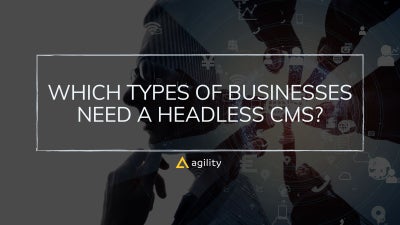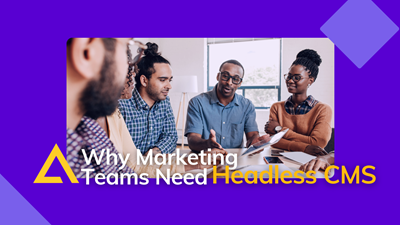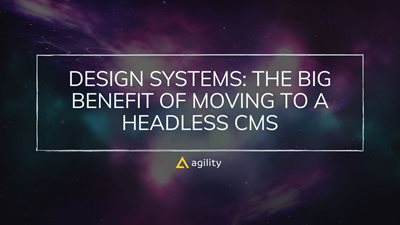Which Types of Businesses Need a Headless CMS?


In a headless content management system, one separates content storage from where it is represented. The storage is called a body, while the place with the content is a ‘’head’’. It differs from other CMS types because they are monolithic systems that work from a single location. A headless CMS's content architecture is decoupled, making it proactive.
It allows users to prepare content in the body and move it into the delivery environment or the head. APIs connect the body and the head of the CMS. It allows content creators to make multiple access requests and modify data to fit each unique need. A headless content strategy framework gives organizations more flexibility and the benefit of a customizable front experience that services every business need. A headless CMS can serve multiple digital channels.
What businesses need a headless CMS and why?
A headless CMS allows for structuring a content strategy framework that is highly robust and SEO ready. It provides a performance-based platform optimized for unlimited types of devices. The content market personnel use little effort to achieve higher productivity. It is essential in developing SEO-ready content that specialists then distribute across multiple devices such as intelligent gadgets, mobile, desktop, and many other platforms. Thus, you save plenty of time and focus on thinking through a killer content marketing campaign than figuring out how to adjust it to various devices.
Regardless of the benefits of self-hosted headless CMS, knowing if your organization needs such a system and the reasons are necessary. Your organization needs a headless CMS architecture to fulfill any of these purposes.
Your organization needs to scale fast.
A headless CMS will offer the best solutions when your organization needs to adopt an agile marketing methodology. This approach provides higher scalability. The method keeps the front-end UX separate from the backend. Due to this, the backend development team works independently from the front-end team. The backend team focuses on content management mechanics, while the front-end team focuses on user-friendly presentation environments. It allows both teams to scale faster while working from both independently.
Your organization needs to build customized, interactive digital experiences.
A self-hosted headless CMS allows an agile content flow structure for customized UX experiences. Many organizations have implemented robust digital transformation strategies in the last few years. Many have adopted mobile apps and mobile-customized content to reach their clients in multiple ways. Headless CMS allows customers to engage directly with brands.
Organizations seeking to build streamlined business processes.
Businesses that want to adopt an agile marketing methodology need to engage in frequent iterations and non-stop feedback. For this to happen, the organization needs to accelerate its business processes. The marketing team needs to generate leads fast, and the sales team needs to connect with customers in real-time.
Organizations need headless CMS because it provides a content architecture that is faster, easier, and highly flexible. It is an API-driven architecture that allows organizations to develop their head or UX from end to end. Organizations can use the architecture for managing apps and website content, including internal administrative content in the same place.
Cases and examples of industries where a headless CMS is much needed
One of the best ways to help you understand headless CMS is to think about a body without a head. Separating the head from the body is not to kill the CMS but to make it function better and faster. It gives the content development team all the freedom to create content without interfering with what is happening on the user's end. On the other hand, developers on the user end get the freedom to create the best user experiences when interacting with the content. A headless CMS list of features includes the following:
- Content localization, where content is delivered to where it is wanted
- Content modelling, where marketers define their content at a granular level
- Definite user roles and permissions
- Presence of a content authoring interface where content developers create content in terms of content items.
- Content Manager UI for simplified content creation processes.
- Omnichannel content publishing capabilities through APIs
- A decoupled content database
- Multiple types of content and well-defined taxonomy
The application of headless CMS for agile digital marketing spans a broad aspect of use scenarios. As e-commerce evolves, marketers need to grow and experiment with multiple types of data and channels. Organizations need to optimize what works for them consistently. Headless CMS is beneficial in the face of Omnichannel marketing, where clients connect with brands through many channels and devices. Marketers can use customer content for traditional, paid, digital, and other communication channels.
The headless CMS list of features gives organizations the advantage of using the architecture in the following:
- SaaS model: when a cloud services provider hosts applications for online use.
- Web-oriented model: User access and use applications via the internet instead of localized computers.
- Semi-decoupled model: Application services accessed from a shared platform such as an Enterprise Service Bus (ESB)
Organizations that need headless CMS most are:
- Large retail enterprises that manage millions of customers daily
- The health sector, due to the growing content demand
- Marketing agencies that do marketing for thousands of organizations
- Motor vehicle manufacturers and sellers
- Electronic device manufacturers and dealers
- The financial services sector
- Fitness centers must develop interactive venues that allow customers to engage with them across various platforms and devices.
A story block used by marketers, visual editors, and content developers is an excellent example of headless CMS. It helps marketers tell stories and manage content for mobile apps, e-commerce, screen displays, websites, and many more.
How a company can smoothly integrate a headless CMS - An overview
Managers must understand headless CMS and its best integration practices to benefit from the process. Integration architecture means bringing every business logic and functionality into multiple APIs. The entire architecture is powered by a specialized CMS backend that avails it to any front-end channel. The APIs act as the connecting channels between both ends to provide the best customer experience in whatever medium they might be using. These steps are necessary if an organization seeks a smooth headless CMS integration process.
Choose the right headless CMS
It is one thing to understand what headless CMS is, but it is another to choose the right one. There are a wide variety of platform options in the market, but their functionalities and features differ. To get the right one, consider these things:
- Your performance expectations: Figure it out in terms of speed, hosting convenience, and responsiveness.
- The purpose of your website: Figure out if your website is expected to serve a long-term or short-term need. If it’s long-term, choose a headless CMS with higher scalability and flexibility for future alignments.
- Consider the developer freedom that you expect: Its features need to give your developers the liberty to customer content and user experience interfaces.
- Your system and content security: Digitally transformed systems require tight online security.
- CMS scalability: The CMS must support sudden changes and growth traffic
- Ease of use: Both developers and marketers should use the headless CMS easily
- Your budget: Go for a headless CMS that does not take your budget overboard.
Consider hosting options available
Any hosting solution may work for most organizations, but it is best to consider a solution that allows customization. Since the CMS has a headless backend and front end, it is best if they are hosted on different servers. Some organizations may consider using a separate host for each lot. Decide if you want your APIs hosted in the cloud on your local server.
Use headless CMS integration best practices
There is always the first step that helps you to get started with the process. However, decide how the implantation will affect business processes and the kind of expectations from each stakeholder. These best practice considerations are important.
Integrating your marketing department
After integration, the marketing team will be presented with a Web User Interface of templates that help manage content input and movement. Marketers break away from traditional CMS that demand programming knowledge and content entry logic frameworks.
The marketing integration best practice requires implementers to match both navigation and site structures to make the navigation of the CMS and the site flawless. The use of third-party tools for creating a blogging marketing strategy is recommended for effectively developing content using headless CMS.
Integrating your IT department
When moving from a traditional CMS to a headless CMS, the experts must create and modify the existing code for use in a SaaS model. It lets the new model work seamlessly with headless CMS APIs and Microservices. Since this is a new architecture that requires a different use approach, technical training for using APIs is required. It helps make every concerned department comfortable with the new development.
Modification and optimization
The process does not stop with ensuring the system is up and running. There is another process that involves modification and optimization. The team of experts must decide the templates to use, the type of content, and the structure that matches the templates.
The marketing team might use the default structures available and customize others. There is also a need to increase content destinations such as mobile devices and wearables. In a headless CMS architecture, all content resides in one place/the CMS backend but is distributed in multiple ways.
What businesses don’t need a headless CMS, and why?
A headless CMS is an excellent option for a business. Regardless, your organization might not need a headless CMS solution for various reasons.
- Your organization has simple content publishing needs: Headless CMS requires a lot of input from developers due to evolving content structures. A traditional CMS will be better if your publishing needs are not complicated.
- Your support capacity is limited: Headless CMS requires building the front end from scratch. Once it is separated from the back end, it means the front side is left empty. It would help if you experienced technical staff to recreate the front end afresh. It means providing more resources, changing infrastructure, and having an experienced team of developers full-time. If your organization lacks this staffing structure, it is best to stick with a traditional CMS.
- Your organization is yet to hit the fast-growth highway: You understand your organization well in terms of where it is currently and its expected future. If you do not expect it to experience fast growth soon, hold on to your traditional CMS.
Some organizations do not need headless CMS solutions because it requires a more complex architecture. The architecture has a broad base of features that require high-tech design, management, and maintenance. Due to its complexities, headless CMS is capital-intensive. Its costs might continue getting complex since you must set aside fees for the CMS, hosting, developer, apps, and infrastructure.
Examples of industries that work better with other content marketing management systems
Some companies will work better with other types of content marketing management systems. Traditional CMS allows organizations to connect with both the front–and back-end of their websites through an easy-to-use app code. The CMS contains everything in one place, starting with content storage to the presentation end.
There is a wide variety of organizations that leverage traditional CMS in all their operations. These companies reap more benefits using a conventional CMS than when they choose to use headless CMS solutions. The architecture is user-friendly, fast to deploy, and easy to maintain. The CMS is cost-effective and provides support from a large community of developers. Organizations use it for broad-based purposes that include:
- Content storage
- Access control
- Content publishing
- Report analysis and generation
- Indexing
- Search, retrieval, and management
Many organizations would benefit more from a traditional CMS than a headless CMS. These are
- News print media: These are organizations that print news through traditional means. They must present an electronic form in their newspaper using an ordinary CMS.
- Entertainment organizations: Entertainment companies can be classified as music producers, film industry, art, and dance. They record high but not intensive traffic.
- Bloggers: Bloggers manage busy blogs, but they might not need the solutions of a headless CMS.
- Small and medium retail stores: These are stores that operate within a state or a few states instead of on a national level.
- Travel companies and businesses with less than 1,000 employees. These organizations do not generate terabytes of content or manage millions of subscribers/ customers.
Headless CMS is ideal for busy websites and complex applications requiring highbred architecture. The technology is not held to a single presentation layer. Instead, it can be used for content management for websites and applications. Its advantages include flexibility, ease of use, Omnichannel support, and better online security. Headless CMS differs from other solutions because it allows content creators to develop decoupled infrastructure. Different CMS types are monolithic, meaning everything is included in one place.

About the Author
Agility CMS is Canada's original headless CMS platform. Since 2002, Agility has helped companies across Canada and around the world better manage their content. Marketers are free to create the content they want, when they want it. Developers are empowered to build what they want, how they want.
- Get a demo for a personalized walkthrough.
- Try for FREE and experience Agility CMS.
- Contact us with your questions.
View Related Resources

From a Monolithic CMS to a Headless CMS (How to Guide)

Why Marketers Need a Headless CMS

Design Systems: The Big Benefit of Moving to a Headless CMS
Request an Agility CMS Demo
Discover how Agility CMS can help your team build powerful digital experiences
Book a Demo